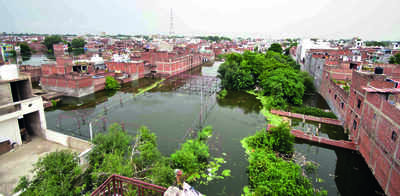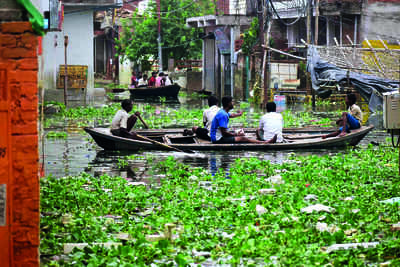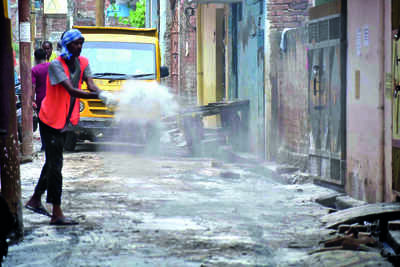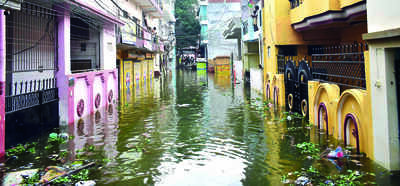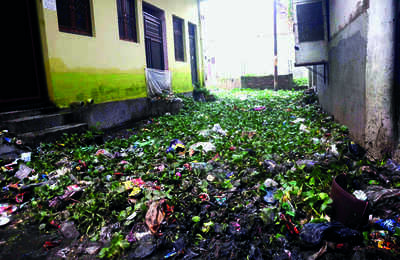- News
- City News
- allahabad News
- A sigh of relief as Ganga, Yamuna now flow below red mark
A sigh of relief as Ganga, Yamuna now flow below red mark
Prayagraj: After flowing above the red mark for the past five days— Ganga and Yamuna had breached the danger mark of 84.734m on August 26— water level in the twin rivers have climbed down below the danger mark and is expected to recede further in coming days.
While the water level in Ganga has come below the danger mark of 84.734m at both Phaphamau and Chatnaag along with a similar trend of Yamuna at Naini, as per the reading of 6pm, on Wednesday. While Ganga was receding at a rate of around 14 cm every 2 hours, water in Yamuna also receded at a rate of around 12cm at a gap of 2 hours.
If compared to the last 24 hours (as per reading on 4pm of Tuesday and that of same time on Wednesday), water in Ganga had come down by 98cm at Phaphamau and above 1.04m at Chatnaag. Likewise, water level in Yamuna had come down by 1.11m in the past 24 hours. As per reading at 6pm (on Wednesday), water level in Ganga was at 84.65m at Phaphamau and 83.68m at Chatnaag. Likewise, water level in Yamuna at Naini was 84.39m.
Experts say now that the water level is receding fast in Prayagraj, the same would start showing relief further downstream. As the water is reducing in Ganga, the water level would come down below the danger mark at Phaphamau too by late evening.
“As the water level would come down at Phaphamau, it will not only provide relief directly to inundated areas of Ashok Nagar and Rajapur but the flood-affected areas of Salori and both Chota and Bada Baghada would get relief,” said executive engineer, flood control department, Brijesh Kumar Verma.
Flood water has also receded in the rural areas giving relief to thousands of villagers and cattle who had taken refuge in relief camps.
Flood water has started receding in areas like Chota Baghada, Bara Baghada, Bakshi Khurd, Sadiabad, Shivkuti, Guas Nagar, Salori, Karelabagh, Daragunj, Nagvasuki, Harshvardhan nagar etc. This has brought some relief to locals and the administration as many of the localities that were earlier approachable only by boats are now accessible by cycle or even by walking.
While some locals have even started coming back to their houses others are providing relied materials to those who stayed back to guard their belongings.
“In our locality, while the families had shifted to relief camps, many students stayed back. But now as the water is receding many of them are coming back,” said Rajan one of the students at Chota Baghada locality.
But receding water has left a trail of damage.
Piles of garbage, silt, rotten vegetation, sewage, plastic etc can be seen on the road. Also, locals claim surge in sightings of snakes, insects and other reptiles.
“Many youths of our locality are not undertaking the cleaning task because of the fear of snakes and insects,” said Nilam, a resident of Salori. Besides, no power has compounded the problems, especially during the night. The district administration said they were working on a war footing to remove the garbage.
“Now that the flood is ebbing, it is leaving behind piles of garbage and filth. We have started cleaning work in these localities,” said ADM (F/R) Jagdamba Singh.“We are running 17 camps in the city limits wherein 1325 families (6297 individuals, including 508 kids) are staying. Besides, we have established four relief camps in rural areas— three in Soraon and one at Bara block,” said Singh.
Further a total of 262 boats have been pressed into service, he added.
While the water level in Ganga has come below the danger mark of 84.734m at both Phaphamau and Chatnaag along with a similar trend of Yamuna at Naini, as per the reading of 6pm, on Wednesday. While Ganga was receding at a rate of around 14 cm every 2 hours, water in Yamuna also receded at a rate of around 12cm at a gap of 2 hours.
If compared to the last 24 hours (as per reading on 4pm of Tuesday and that of same time on Wednesday), water in Ganga had come down by 98cm at Phaphamau and above 1.04m at Chatnaag. Likewise, water level in Yamuna had come down by 1.11m in the past 24 hours. As per reading at 6pm (on Wednesday), water level in Ganga was at 84.65m at Phaphamau and 83.68m at Chatnaag. Likewise, water level in Yamuna at Naini was 84.39m.
Experts say now that the water level is receding fast in Prayagraj, the same would start showing relief further downstream. As the water is reducing in Ganga, the water level would come down below the danger mark at Phaphamau too by late evening.
“As the water level would come down at Phaphamau, it will not only provide relief directly to inundated areas of Ashok Nagar and Rajapur but the flood-affected areas of Salori and both Chota and Bada Baghada would get relief,” said executive engineer, flood control department, Brijesh Kumar Verma.
Flood water has also receded in the rural areas giving relief to thousands of villagers and cattle who had taken refuge in relief camps.
Flood water has started receding in areas like Chota Baghada, Bara Baghada, Bakshi Khurd, Sadiabad, Shivkuti, Guas Nagar, Salori, Karelabagh, Daragunj, Nagvasuki, Harshvardhan nagar etc. This has brought some relief to locals and the administration as many of the localities that were earlier approachable only by boats are now accessible by cycle or even by walking.
While some locals have even started coming back to their houses others are providing relied materials to those who stayed back to guard their belongings.
“In our locality, while the families had shifted to relief camps, many students stayed back. But now as the water is receding many of them are coming back,” said Rajan one of the students at Chota Baghada locality.
But receding water has left a trail of damage.
Piles of garbage, silt, rotten vegetation, sewage, plastic etc can be seen on the road. Also, locals claim surge in sightings of snakes, insects and other reptiles.
“Many youths of our locality are not undertaking the cleaning task because of the fear of snakes and insects,” said Nilam, a resident of Salori. Besides, no power has compounded the problems, especially during the night. The district administration said they were working on a war footing to remove the garbage.
“Now that the flood is ebbing, it is leaving behind piles of garbage and filth. We have started cleaning work in these localities,” said ADM (F/R) Jagdamba Singh.“We are running 17 camps in the city limits wherein 1325 families (6297 individuals, including 508 kids) are staying. Besides, we have established four relief camps in rural areas— three in Soraon and one at Bara block,” said Singh.
Further a total of 262 boats have been pressed into service, he added.
FOLLOW US ON SOCIAL MEDIA
FacebookTwitterInstagramKOO APPYOUTUBE
Start a Conversation
end of article

